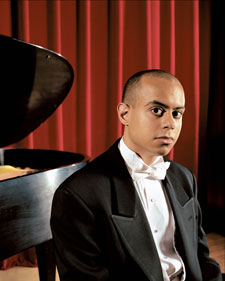Miami Symphony opens season with Beatles-inspired premiere

The Miami Symphony Orchestra opened its season Sunday with the world premiere of Sam Hyken’s Beatles Guide to the Orchestra. Hyken, currently involved in the Miami Music Project Orchestral Academy, is the orchestra’s principal trumpet player and has a definite interest in the merging of disparate styles of music. The Arsht Center’s Knight Concert Hall provided the showcase for his skillful symphonic arrangement of several Beatles’ tunes into a narrated orchestral guide clearly modeled on that of Benjamin Britten.
The Beatles Guide is an eclectic piece in popular style, with elements of jazz. Opening with what sounded like Lloyd Webber’s Jesus Christ, Superstar, it quickly segued into Octopus’s Garden and took off from there. The orchestration and arrangement were skillful and, if Britten got to the finish first, this imitation as the sincerest form of flattery even went so far as to include a fugue during the closing pages, as did Britten. The audience gave a standing ovation to Hyken and embraced this entertaining music with great enthusiasm. It would be surprising if the music does not emerge as a pop concert favorite. The orchestra, under Eduardo Marturet played with style and spirit.
Two popular warhorses completed the program. Tchaikovsky’s familiar Piano Concerto No. 1 in B-flat minor can sometimes seem a chore to sit through if routinely performed. From the opening bracing statement of the horns it was clear that both conductor and players aspired to something more.

Stewart Goodyear/ Photo: Andrew Garn
Pianist Stewart Goodyear, a student of Oxana Yablonskaya, Leon Fleisher, Gary Graffman and Claude Frank, entered with muscular authority, and a determination to banish all thought of the ordinary. This he achieved by using his varied tone and fleet fingerwork to bring a new freshness to this jaded masterwork. Marturet gave his timpani player an unusual amount of sonic freedom, and the resultant strength of the music was underlined.
Goodyear played the Andantino with beautifully rapt expression, and the breakaway Prestissimo took off like lightening. A few clashes of tempo between orchestra and piano, here and in the final movement, almost threatened to disrupt things, but recovery was quick, with perfection sacrificed to the excitement of the moment. Even with a cacophony of audience coughs and sneezes, what came through was a performance as fresh, vigorous, and thrilling as any to be heard.
Quickly re-entering from the wings, Marturet hopped onto the podium and immediately began the famous “fate” motif of Beethoven’s Fifth Symphony. This was to be a no-nonsense performance, expressive of all the anger and frustration felt by the composer over his increasing deafness. Tempos were quick, all repeats taken, and the rousing horns sounding forth as if life depended on their sheer raw, bold power. With the conductor refusing to rein in the timpani, the music took on a new, and more forceful dimension of power and excitement. By the time the trombones entered for the final Allegro, the performance had grown into quite an achievement for the Miami Symphony Orchestra, with only the reticent piccolo buried during the jubilant final moments.
Posted in Performances
Leave a Comment
Mon Oct 24, 2011
at 10:51 am
No Comments






